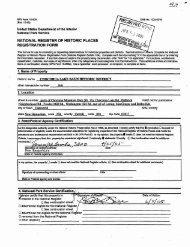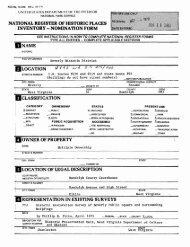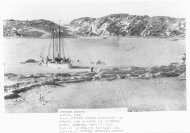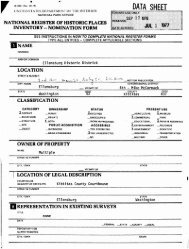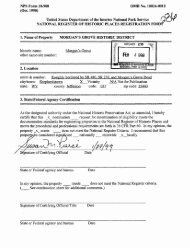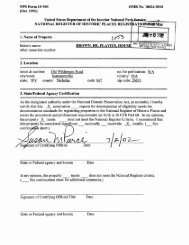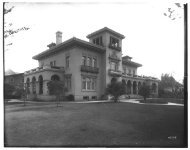National Register of Historic Places Inventory Nomination Form
National Register of Historic Places Inventory Nomination Form
National Register of Historic Places Inventory Nomination Form
You also want an ePaper? Increase the reach of your titles
YUMPU automatically turns print PDFs into web optimized ePapers that Google loves.
NPS <strong>Form</strong> 10400<br />
N. H. L. ARCHITECTURE IN THE PARKS<br />
United States Department <strong>of</strong> the Interior<br />
<strong>National</strong> Park Service<br />
<strong>National</strong> <strong>Register</strong> <strong>of</strong>f <strong>Historic</strong> <strong>Places</strong><br />
<strong>Inventory</strong> <strong>Nomination</strong> <strong>Form</strong><br />
See instructions in How to Complete <strong>National</strong> <strong>Register</strong> <strong>Form</strong>s<br />
Type all entries complete applicable sections_______________<br />
1. Name__________________<br />
historic The Ahwahnee Hotel ___ __<br />
and or common_____________________________________<br />
2. Location________________<br />
street & number Yosemite Valley<br />
city, town Yosemite <strong>National</strong> Park __ vicinity <strong>of</strong><br />
OHB Ho. 1024-001B<br />
Expires 10-31-87<br />
For NPS UM only<br />
received<br />
date entered<br />
not for publication<br />
state California code 06 county Mariposa code 043<br />
3. Classification<br />
Category Ownership<br />
__ district __ public<br />
_x buildlng(s) —x. private<br />
__ structure<br />
__site<br />
__ object<br />
__both<br />
Public Acquisition<br />
__ in process<br />
__ being considered<br />
4. Owner <strong>of</strong>f Property<br />
name Yosemite Park and Curry Company<br />
street & number<br />
Status<br />
_JL_ occupied<br />
__ unoccupied<br />
__ work in progress<br />
Accessible<br />
x yes: restricted<br />
__ yes: unrestricted<br />
__"no<br />
Present Use<br />
__ agriculture<br />
__ commercial<br />
__ educational<br />
__ entertainment<br />
__ government<br />
__ industrial<br />
__ military<br />
city, town Yosemite <strong>National</strong> Park . vicinity <strong>of</strong> state California<br />
5. Location <strong>of</strong>f Legal Description<br />
courthouse, registry <strong>of</strong> deeds, etc. Mariposa County Courthouse<br />
street & number<br />
city, town Mariposa state California<br />
6. Representation in Existing Surveys<br />
__ museum<br />
__park<br />
__ private residence<br />
__ religious<br />
__ scientific<br />
__transportation<br />
_JS_ other: Luxury Hotel<br />
title <strong>National</strong> <strong>Register</strong> <strong>of</strong> <strong>Historic</strong> <strong>Places</strong> has this property been determined eligible? __ yes<br />
1977 _x_ federal __stale __county _<br />
depository for survey records <strong>National</strong> Park Service<br />
ctty, town Washington state D. C.<br />
.no<br />
local
7. Description<br />
Condition Check one Check one<br />
__ excellent __ deteriorated __ unaltered K original site<br />
_x good __ ruins x altered __ moved date<br />
__ fair __ unexposed<br />
Doscribo tho prevent and original (if known) physical appearance<br />
The Ahwahnee is an enormous luxury hotel at the east end <strong>of</strong> the<br />
Yosemite Valley. Sited in a meadow, the building's large scale<br />
is diminished by the awesome beauty <strong>of</strong> the sheer granite cliffs<br />
<strong>of</strong> the north valley wall above. The building's name comes from a<br />
local Indian word meaning "deep, grassy meadow."<br />
The building has an irregular, asymmetrical plan that is Y-<br />
shaped and contains 150,000 square feet. Primary building<br />
materials are rough-cut granite and concrete. The uncoursed<br />
granite rubble masonry <strong>of</strong> the piers matches the color <strong>of</strong> the<br />
adjacent cliffs. What looks like wood siding and structural<br />
timbers between the piers is actually concrete, poured into<br />
formwork that shapes it to look like horizontal redwood siding<br />
and large milled timbers. The stain on the concrete, similar in<br />
color to pine bark and redwood lumber, reinforces that illusion<br />
that the fabric is wood.<br />
The building is massed into several enormous blocks with a six-<br />
story central block and wings <strong>of</strong> three stories. The multiple hip<br />
and gable ra<strong>of</strong>s are finished with green slate and further break<br />
up the building's form, making it appear as rough and textured as<br />
the surrounding landscape. The building has balconies and<br />
terraces at several different levels that add a spatial interest<br />
not only to the exterior but also to the visitor experiencing the<br />
interior <strong>of</strong> the building. The building contains approximately 95<br />
guest rooms, various public spaces and meeting rooms, an enormous<br />
dining room, and utility spaces. The principal entrance to the<br />
building is through a porte-cochere on the north side <strong>of</strong> the<br />
building. The log and wood entrance contains painted decorations<br />
in Indian patterns, setting a tone for the interior. This<br />
entrance serves mainly as a utilitarian space to funnel the<br />
visitor to the building's interior, and to the views <strong>of</strong> the<br />
grassy meadow to the south and the impressive vistas seen from<br />
most <strong>of</strong> the rooms. The main entrance is more subdued than<br />
noteworthy; the most impressive views <strong>of</strong> the hotel are from the<br />
southern meadows.<br />
The north wing <strong>of</strong> the hotel contains the lobby, decorated with<br />
floor mosaics <strong>of</strong> Indian designs executed in brightly colored<br />
rubber tiles. The cornice is stencilled with Indian-design<br />
paintings. The elevator lobby continues the Indian designs with<br />
sawn-wood reliefs on the elevator doors and an abstract mural<br />
based on Indian basket patterns over the fireplace in that room.<br />
The Great Lounge's 24-foot-high ceiling has exposed girders and<br />
beams painted with bands <strong>of</strong> Indian designs. The exposure <strong>of</strong> the<br />
ceiling's structure gives the spatial impression <strong>of</strong> a c<strong>of</strong>fered
8. Significance<br />
Period Areas <strong>of</strong> Significance Check and justify below<br />
__ prehistoric __. archeology-prehistoric _ ._ community planning _ _ landscape architecture.__ religion<br />
__1400-1499 __archeology-historic . conservation ___law __science<br />
__1500-1599 __agriculture __economics _ literature __sculpture<br />
__ 1600-1699 _X- architecture _. education ._ military __ social/<br />
__1700-1799 -_x_art . .engineering __music humanitarian<br />
__1800-1899 __commerce __.exploration/settlement__philosophy __theater<br />
_2C 1900-Presen£_ communications .._ industry __ politics/government __ transportation<br />
_ invention __ other (specify)<br />
Specific dates 1925 - Present Builder/Architect Gilbert Stanley Underwood for the<br />
——————————-—————————————————————-—————Yosemits Park and Curry Company—<br />
Statement <strong>of</strong> Significance (in one paragraph)<br />
The principal significance <strong>of</strong> the Ahwahnee lies in its monumental<br />
rustic architecture. Inseparable from that architecture is the<br />
period art work and interior design so carefully executed<br />
throughout the building. Also <strong>of</strong> significance is its importance<br />
as the hostelry that has housed through its history dignitaries,<br />
movie stars, artists, and others having an impact on the<br />
twentieth century. Undoubtedly this is due to the Ahwahnee's<br />
place as the architectural gem <strong>of</strong> monumental luxury <strong>of</strong> a crown<br />
jewel <strong>of</strong> the <strong>National</strong> Park System. Of regional significance is<br />
the Ahwahnee's place in California history and the development <strong>of</strong><br />
the concessions industry at Yosemite <strong>National</strong> Park.<br />
In 1925 Stephen Mather provided considerable urging and $200,000<br />
<strong>of</strong> his own personal fortune for two Yosemite concessionaires to<br />
merge into one company--the Yosemite Park and Curry Company.<br />
Mather had seen the need for a superior hotel at Yosemite but<br />
forced the merger because <strong>of</strong> the fierce competition between the<br />
two companies. Donald B. Tressider, later president <strong>of</strong> Stanford<br />
University, became president <strong>of</strong> the new company. The contract<br />
that the new company signed with the park service required the<br />
construction <strong>of</strong> a new firepro<strong>of</strong> hotel that would have the<br />
capability <strong>of</strong> year round operation. Recommended as architect for<br />
the building was Gilbert Stanley Underwood <strong>of</strong> Los Angeles.<br />
Underwood was an architect <strong>of</strong> considerable reputation and well<br />
known to Stephen Mather, Horace Albright, and others in the park<br />
service when he accepted the commission to design the Ahwahnee.<br />
Underwood began his pr<strong>of</strong>essional career working for architects in<br />
the Los Angeles area who designed structures in every style from<br />
Beaux Arts classicism to Mission Revival. After attending a<br />
series <strong>of</strong> universities he finally received a Bachelor's degree<br />
from Yale, and then a Masters from Harvard. Underwood's first<br />
large works were for the Union Pacific Railroad on Zion and Bryce<br />
Lodges, followed by the Ahwahnee, Graqd Canyon Lodge on the north<br />
rim, a series <strong>of</strong> railroad stations for the Union Pacific,<br />
Timberline Lodge, Sun Valley Lodge, and Williamsburg Lodge.
9. Major Bibliographical References<br />
See continuation sheets.<br />
10. Geographical Data<br />
Acreage <strong>of</strong> nominated property<br />
Quadrangle name<br />
UTM References<br />
. 5<br />
ll.l I 1217,313,0,01 |4|1|8,0|5|8|0| LJ<br />
Northing<br />
Zone<br />
Zone Easting<br />
ci , I I I , L<br />
E| , i i i i |_<br />
Ql . 1 1 1 i L<br />
. • 1 1 i 1 . 1 1 , 1<br />
, , | 1 ,<br />
, , 1 1 ,<br />
1 . 1 , , 1<br />
1 , 1 , , 1<br />
Verbal boundary description and justification<br />
Dl . 1<br />
•=UJ<br />
Hi , 1<br />
Easting<br />
Quadrangle scale<br />
1 1 . 1 , , 1<br />
1 1 . 1 , i 1<br />
1 1 , 1 , , 1<br />
j_I I I<br />
Northing<br />
1 , 1 , 1 , , 1<br />
1 1 1<br />
1 1 1<br />
The boundary is shown as the solid line on the U. S. G. S. map and as the<br />
dotted line on the park planning map.<br />
List all states and counties for properties overlapping state or county boundaries<br />
state N/A code county code<br />
state N/A code county code<br />
11. <strong>Form</strong> Prepared By<br />
name/title Laura Soulliere Harrison Architectural Historian<br />
organization <strong>National</strong> Park Service, Southwest Region date 1986<br />
street A number P.O. Box 728 telephone (505) 988-6787<br />
city or town Santa Fe state New Mexico<br />
12. State <strong>Historic</strong> Preservation Officer Certification<br />
The evaluated significance <strong>of</strong> this property within the state is:<br />
__ national __ state __ local<br />
As the designated State <strong>Historic</strong> Preservation Officer for the <strong>National</strong> <strong>Historic</strong> Preservation Act <strong>of</strong> 1966 (Public Law 89-<br />
665), I hereby nominate this property for inclusion in the <strong>National</strong> <strong>Register</strong> and certify that it has been evaluated<br />
according to the criteria and procedures set forth by the <strong>National</strong> Park Service.<br />
State <strong>Historic</strong> Preservation Officer signature<br />
title<br />
For NPS use only<br />
I hereay certify that this property is included in the <strong>National</strong> Regist*<br />
Keeper <strong>of</strong><br />
_<br />
Chief <strong>of</strong> Registration<br />
OPO att-aaa<br />
date<br />
1 1 1<br />
1 1 1<br />
_u<br />
jj
NPS<strong>Form</strong> 10-9004 OMB y0 _ 1024-OOia<br />
IMZ> Expires 10-31-87<br />
United States Department <strong>of</strong> the Interior<br />
<strong>National</strong> Park Service<br />
<strong>National</strong> <strong>Register</strong> <strong>of</strong> <strong>Historic</strong> <strong>Places</strong><br />
<strong>Inventory</strong> <strong>Nomination</strong> <strong>Form</strong><br />
Continuation sheet ___________ Item number ^ Page<br />
ceiling. The enormous fireplaces at opposite ends <strong>of</strong> the Lounge<br />
are cut sandstone. The wrought-iron chandeliers, Persian rugs<br />
hanging on the walls, and the wood furnishings are original.<br />
Their worth and delicate condition resulted in their conservation<br />
and placement in enclosed cases on the walls. Other oriental<br />
rugs, primarily replacements, are on the polished wooden floor <strong>of</strong><br />
the Great Lounge. The floor-to-ceiling windows in the Great<br />
Lounge have 5x6-foot stained glass panels at the top, with<br />
handsome designs based on Indian patterns, but like many <strong>of</strong> the<br />
other interior elements done with a flatness found in Art Deco<br />
architecture.<br />
Directly <strong>of</strong>f the Lounge are the California Room, the Writing<br />
Room, and the solarium that overlooks the southern meadow. The<br />
California room contains decorations <strong>of</strong> memorabilia from the Gold<br />
Rush days. The Writing Room's principal feature is an oil<br />
painting on linen by Robert Boardman Howard that runs the length<br />
<strong>of</strong> one wall and depicts local flora and fauna in a style<br />
reminiscent <strong>of</strong> medieval tapestries.<br />
The large dining room (6,630 square feet) has a gable-ro<strong>of</strong>ed<br />
ceiling 34 feet high at the ridge. The walls are massive granite<br />
piers interspersed with 11 floor-to-ceiling windows with the<br />
exception <strong>of</strong> the partition wall between the kitchen and dining<br />
room which has a six-foot wainscotting <strong>of</strong> wood panelling with<br />
plaster above. The sugar-pine ro<strong>of</strong> trusses are supported by<br />
concrete "logs" again painted in imitation <strong>of</strong> the real thing.<br />
Original wooden furniture and wrought-iron chandeliers remain in<br />
use.<br />
Also included within the boundaries <strong>of</strong> this nomination are the<br />
meadow directly south <strong>of</strong> the hotel, the stone gatehouse marking<br />
the entrance to the property, the parking lots, and the small<br />
pond and walkways at the building's entrance, directly north <strong>of</strong><br />
the porte-cochere.<br />
Changes to the hotel over time have been in keeping with the<br />
structure. The architecture, designed by Gilbert Stanley<br />
Underwood, was enhanced by the interior design directed by Drs.<br />
Phyllis Ackerman and Arthur Upham Pope. The stained glass work<br />
and mural over the fireplace in the elevator lobby were the work<br />
<strong>of</strong> San Francisco artist Jeannette Dyer Spencer. The Howard mural<br />
in the Writing Room, also produced under their direction,<br />
contributed to the medieval allusions that crop up throughout the<br />
building, particularly in the heavy-handed wrought ironwork.
NFS <strong>Form</strong> 10-MO-i OHS iVo 1024-0018<br />
*^ Expires 10-31-87<br />
United States Department <strong>of</strong> the Interior<br />
<strong>National</strong> Park Service<br />
<strong>National</strong> <strong>Register</strong> <strong>of</strong> <strong>Historic</strong> <strong>Places</strong><br />
<strong>Inventory</strong> <strong>Nomination</strong> <strong>Form</strong><br />
Continuation sheet Item number ? Page<br />
These were all completed prior to the opening in July, 1927. The<br />
sixth-floor ro<strong>of</strong> garden and dance hall was turned into an<br />
apartment for the Tressider family about 1928 after the area's<br />
function as a dance hall did not work. The apartment was<br />
remodelled again much later when a private guest suite and<br />
sunroom were added. The trusses in the dining room were beefed<br />
up in 1931-32 when the Company's architect discovered that they<br />
were minimally designed for the snow loads and earthquake<br />
stresses they needed to bear.<br />
At the end <strong>of</strong> Prohibition in 1933 a private dining room on the<br />
hotel's mezzanine level was remodelled into a bar called "El<br />
Dorado Diggins" complete with false storefront and antiques from<br />
the Gold Rush days. In 1943 the U.S. Navy's takeover <strong>of</strong> the<br />
building as a convalescent hospital for war wounded resulted in<br />
major temporary changes to the grounds. When the Navy evacuated<br />
the structure they did considerable painting on the interior.<br />
The smaller maids' and chauffers' rooms were remodelled into<br />
guest rooms after the War when fewer guests brought their own<br />
servants. In 1950 the original porte-cochere which had been<br />
enclosed by the Navy was remodelled into the Indian Room a<br />
multi-purpose space for meetings, dances, and the like. The fire<br />
alarm system and exterior fire escapes also were added during the<br />
1950s. In 1963 the outdoor swimming pool and automatic elevators<br />
were installed. All <strong>of</strong> the smaller windows in the building were<br />
replaced during the 1970s and some spelling concrete was repaired<br />
at the same time. Smoke detectors were installed in all rooms<br />
during the late 1970s, transoms above doors to guest rooms were<br />
sealed <strong>of</strong>f, and fire doors were put on the exit doors to the fire<br />
escapes. At the same time a sprinkler system was added to<br />
portions <strong>of</strong> the building--the local water supply could not<br />
support a complete system. The sixth-floor apartment which had<br />
been remodelled during 1970-71 underwent further remodelling in<br />
the early 1980s in preparation for the visit by Queen Elizabeth<br />
II at which time a new bath and new kitchen were added. The<br />
kitchen has been upgraded periodically over the building's<br />
history. Other utility areas retain original configuration and<br />
updated equipment.
NPS <strong>Form</strong> 10-MO-l OHB f,o. 1024-0018<br />
****' Expires 10-31-87<br />
United States Department <strong>of</strong>f the Interior<br />
<strong>National</strong> Park Service<br />
<strong>National</strong> <strong>Register</strong> <strong>of</strong>f <strong>Historic</strong> <strong>Places</strong><br />
<strong>Inventory</strong> <strong>Nomination</strong> <strong>Form</strong><br />
P<br />
Continuation sheet Item number Page<br />
Underwood's other work included the San Francisco Mint, the<br />
Federal courthouses in Los Angeles and Seattle, and the first<br />
unit <strong>of</strong> the State Department Building in Washington.<br />
Albright, Mather, and Secretary <strong>of</strong> the Interior Hubert Work and<br />
Donald Tressider chose the site for Yosemite's new hotel.<br />
Besides choosing an area unobtrusive in its setting yet with<br />
magnificent vistas, Albright commented:<br />
We felt by <strong>of</strong>fering a quiet, restful, spacious hotel<br />
that many well-to-do, influential people who had ceased<br />
coming to Yosemite, owing to the crowds, could be led<br />
to return to us again and that furthermore the Ahwahnee<br />
would give us a suitable unit in which to promote all-<br />
year business, <strong>of</strong>fering the most luxurious comfort at<br />
all seasons <strong>of</strong> the year.l<br />
Albright saw the building as a drawing card not only to increase<br />
tourism to Yosemite and at that time park appropriations were<br />
directly related to numbers <strong>of</strong> visitors but undoubtedly as a<br />
special haven for the important and influential whose backing <strong>of</strong><br />
national parks was always welcome. After all, it never hurt to<br />
have friends.<br />
In designing the building Underwood took great care in choosing<br />
the materials and the treatment <strong>of</strong> the materials. The stone, for<br />
instance, was weathered granite set in the wall with only the<br />
weathered face exposed. This treatment which appeared in the<br />
specifications for the Ahwahnee became standard park service<br />
practice in rustic buildings where masonry was used. The exposed<br />
concrete was designed to imitate wood in color, form, and<br />
texture. Underwood's blocky masses <strong>of</strong> the building that stepped<br />
up the structure to the penthouse gave the building a physical<br />
presence in architecture that was parallel to the presence <strong>of</strong><br />
Half Dome in nature. Underwood succeeded in his assignment <strong>of</strong><br />
designing a building that fit with its magnificent setting.<br />
1 Zaitlin, Joyce, "Underwood: His Spanish Revival, Rustic,<br />
Art Deco, Railroad, and Federal Architecture," manuscript dated<br />
1983 on file at <strong>National</strong> Park Service, Rocky Mountain Regional<br />
Office. Zaitlin quotes from Albright memorandum on the Ahwahnee<br />
Development, Olmsted Brothers file, Yosemite <strong>National</strong> Park<br />
Research Library.
NPS F<strong>of</strong>m 10-900-i OHB ,Vo _ 1024-0018<br />
***** Expires 10-31-87<br />
United States Department <strong>of</strong> the Interior<br />
<strong>National</strong> Park Service<br />
<strong>National</strong> <strong>Register</strong> <strong>of</strong> <strong>Historic</strong> <strong>Places</strong><br />
<strong>Inventory</strong> <strong>Nomination</strong> <strong>Form</strong><br />
Continuation sheet ________________Item number 8_______ ____Rage 3<br />
Work on the building progressed slowly and cost overruns were<br />
enormous. As the interior began taking shape the Yosemite Park<br />
and Curry Company hired Drs. Phyllis Ackerman and Arthur Upham<br />
Pope, experts in art history, to guide interior decoration <strong>of</strong><br />
Underwood's Cyclopean structure. They commissioned Jeannette<br />
Dyer Spencer's stained glass windows in the Great Lounge and<br />
basket-design mural in the Lobby. They had Robert Boardman<br />
Howard paint a subdued mural for the writing room reminiscent <strong>of</strong><br />
medieval tapestries. They personally chose the killims and<br />
Persian rugs used on the interior. Photographer Ansel Adams was<br />
so taken with the building that he wrote:<br />
...yet on entering The Ahwahnee one is conscious <strong>of</strong><br />
calm and complete beauty echoing the mood <strong>of</strong> majesty<br />
and peace that is the essential quality <strong>of</strong><br />
Yosemite....against a background <strong>of</strong> forest and<br />
precipice the architect has nestled the great structure<br />
<strong>of</strong> granite, scaling his design with sky and space and<br />
stone. To the interior all ornamentation has been<br />
confined, and therein lies a miracle <strong>of</strong> color and<br />
design. The Indian motif is supreme.... The designs are<br />
stylized with tasteful sophistication; decidedly<br />
Indian, yet decidedly more than Indian, they epitomize<br />
the involved and intricate symbolism <strong>of</strong> primitive<br />
man.... 2<br />
When the Ahwahnee opened its doors to the public in July, 1927,<br />
the consensus was that it was worth the wait. The Ahwahnee<br />
became the impressive building that Mather wanted in those<br />
awesome surroundings. Through the years the building housed an<br />
enormous variety <strong>of</strong> people: movie stars, heads <strong>of</strong> state,<br />
artists, and influential politicians. The guest list included<br />
Dwight D. Eisenhower, Haile Selassie, the Shah <strong>of</strong> Iran, Herbert<br />
Hoover, Eleanor Roosevelt, Will Rogers, Gertrude Stein, Charlie<br />
Chaplin, Will Rogers, Lucille Ball, Ronald Reagan, Walt Disney,<br />
Greta Garbo, John F. Kennedy, and most recently Queen Elizabeth<br />
II and Prince Phillip. Photographer Ansel Adams spent<br />
considerable time in the building, frequently breakfasting in the<br />
dining room while in residence at the park. Even today<br />
limousines remain commonplace in the parking lot. Perhaps more<br />
2 Ansel Adams, untitled two-page typewritten document on the<br />
Ahwahnee, no date, pp. 1-2. On file at the Yosemite <strong>National</strong><br />
Park Research Library.
NPS Forni 104004 OMB Ho. 1024-0018<br />
Expires 10-31-87<br />
United States Department <strong>of</strong>f the Interior<br />
<strong>National</strong> Park Service<br />
<strong>National</strong> <strong>Register</strong> <strong>of</strong> <strong>Historic</strong> <strong>Places</strong><br />
<strong>Inventory</strong> <strong>Nomination</strong> <strong>Form</strong><br />
Continuation sheet Item number 8 Page<br />
important than the list <strong>of</strong> dignitaries and famous people who have<br />
spent time in the Ahwahnee is the hotel's place as the heart <strong>of</strong><br />
the aesthetic idea <strong>of</strong> Yosemite. The magnificent scenery <strong>of</strong> the<br />
valley is enhanced by the building's artful contributions to the<br />
ambience <strong>of</strong> the Yosemite experience.
NP8FomHO-9004 OHB NO. 1024-0018<br />
1 T



